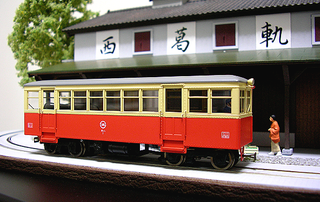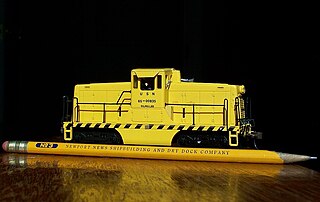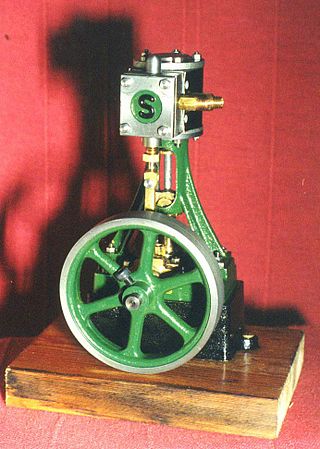Related Research Articles

Railway modelling or model railroading is a hobby in which rail transport systems are modelled at a reduced scale.

A model car, or toy car, is a miniature representation of an automobile. Other miniature motor vehicles, such as trucks, buses, or even ATVs, etc. are often included in this general category. Because many miniature vehicles were originally aimed at children as playthings, there is no precise difference between a model car and a toy car, yet the word 'model' implies either assembly required or the accurate rendering of an actual vehicle at smaller scale. The kit building hobby became popular through the 1950s, while the collecting of miniatures by adults started to pick up momentum around 1970. Precision-detailed miniatures made specifically for adults are a significant part of the market since the mid-1980s.

HO or H0 is a rail transport modelling scale using a 1:87 scale. It is the most popular scale of model railway in the world. The rails are spaced 16.5 millimetres (0.650 in) apart for modelling 1,435 mm standard gauge tracks and trains in HO.

N scale is a popular model railway scale. Depending upon the manufacturer, the scale ranges from 1:148 to 1:160. In all cases, the gauge is 9 mm or 0.354 in. The term N gauge refers to the track dimensions, but in the United Kingdom in particular British N gauge refers to a 1:148 scale with 1:160 track gauge modelling. The terms N scale and N gauge are often inaccurately used interchangeably, as scale is defined as ratio or proportion of the model, and gauge only as a distance between rails. The scale 1:148 defines the rail-to-rail gauge equal to 9 mm exactly, so when calculating the rail or track use 1:160 and for engines and car wheel base use 1:148.

TT scale is a model railroading scale, whose name stands for table top.

Bachmann Industries is a Bermuda-registered, Chinese-owned company, globally headquartered in Hong Kong; specialising in model railroading.

Lionel Corporation was an American toy manufacturer and holding company of retailers that had been in business for over 120 years. It was founded as an electrical novelties company. Lionel specialized in various products throughout its existence. Toy trains and model railroads were its main claim to fame. Lionel trains have been produced since 1900, and their trains drew admiration from model railroaders around the world for the solidity of their construction and the authenticity of their detail. During its peak years in the 1950s, the company sold $25 million worth of trains per year. In 2006, Lionel's electric train became the first electric toy inducted into the National Toy Hall of Fame. In 1969, they sold their model train lines to General Mills, but continued to operate until 1993 as a holding company for their toy stores. Its model trains are still in production as a separate company.

Model engineering is the pursuit of constructing proportionally-scaled miniature working representations of full-sized machines. It is a branch of metalworking with a strong emphasis on artisanry, as opposed to mass production. While now mainly a hobby, in the past it also had commercial and industrial purpose. The term 'model engineering' was in use by 1888. In the United States, the term 'home shop machinist' is often used instead, although arguably the scope of this term is broader.

The Consolidation Line was a series of diesel-electric railway locomotive designs produced by Fairbanks-Morse and its Canadian licensee, the Canadian Locomotive Company. Railfans have dubbed these locomotives “C-liners”, however F-M referred to the models collectively as the C-Line. A combined total of 165 units were produced by F-M and the CLC between 1950 and 1955.
Tyco Toys was an American toy manufacturer. It was acquired by Mattel in 1997.

Athearn is a United States manufacturer of model railroad equipment, produced and distributed by American hobby manufacturer Horizon Hobby, Inc. of Champaign, Illinois.

Life-Like was a manufacturer of model trains and accessories. In 1960, the company purchased the assets of the defunct Varney Scale Models and began manufacturing model trains and accessories under the name Life-Like in 1970. In 2005 the parent company, Lifoam Industries, LLC, chose to concentrate on their core products and sold their model railroad operations to hobby distributor Wm. K. Walthers. Today, the Life-Like trademark is used by Walthers for HO Scale Buildings.

Atlas Model Railroad Company, Inc. makes scale models in N scale, HO scale, and O scale. The company is based in Hillside, New Jersey, United States. They produce a wide variety of locomotives, rolling stock, and vehicles. Atlas is well known for their flex track and codes 55, 80, 83 and 100 track. Atlas also produces a line of compatible structures and bridges.
Penn Line Manufacturing was a United States manufacturer of model railroad equipment, produced in Boyertown, Pennsylvania.
Varney Scale Models was founded in 1936 by Gordon Varney, an early pioneer in manufacturing HO scale model trains. The development of a reliable 6-volt motor made it possible to produce model locomotives capable of pulling long trains. The company relocated from Chicago, Illinois, to Miami, Florida, in 1955. Varney sold his company to Sol Kramer in 1960, which became the basis for launching his own line of Life-Like Trains in 1970. Varney models were above average in quality and detail and are still quite popular with collectors and model railroad enthusiasts.

Class L1s on the Pennsylvania Railroad comprised 574 2-8-2 "Mikado" type steam locomotives constructed between 1914 and 1919 by the railroad's own Juniata Shops as well as the Baldwin Locomotive Works (205) and the Lima Locomotive Works (25). It was the largest class of 2-8-2 locomotives anywhere, although other railroads had more Mikados in total.

Rosebud Kitmaster is the brand name of a short-lived but critically acclaimed range of plastic assembly kits, manufactured in the United Kingdom by Rosebud Dolls Ltd of Raunds, Northamptonshire. Introduced from May 1959, the range rapidly expanded to include 34 models of railway locomotives and coaches in OO, HO and TT scales, and eventually, one motorcycle in 1:16 scale.

On2 gauge is part of the hobby of rail transport modeling. The name is based on the common USA model railroad O scale of 1:48 and refers to the gauge between the rails and the fact that it is narrow gauge, thus 'On2'.

Pennsylvania Railroad 5550 is a mainline duplex drive steam locomotive under construction in the United States. With an estimated completion by 2030, the locomotive will become the 53rd example of the Pennsylvania Railroad's T1 steam locomotive class and the only operational locomotive of its type. The estimated cost of PRR 5550 was originally $10 million, but an updated projected cost of $7 million was released with the acquisition of an existing long-haul tender from the Western New York Railway Historical Society in August 2017. Construction began in 2014 with the casting of the locomotive's keystone-shaped number plate. Major components, including two Boxpok drivers, the prow, the cab, third-course boiler, and fire door have been completed.

The GE 25-ton switcher is a model of diesel-electric switcher locomotive that was produced by GE Transportation at their Erie, Pennsylvania, facility between 1941 and 1974. Most examples were produced for industrial customers or the United States Armed Forces, although a number of examples were purchased by freight railroads as well. The majority of production was for customers in the United States and Canada, but export models were produced for buyers on five continents. Production totaled approximately 550 units over 33 years, making it one of the most widely produced switchers in American history.
References
- ↑ Steve Gill and Bill Bowser. "Model Railroad Classics: Bowser Manufacturing". Railroad.net. Archived from the original on 2 January 2015. Retrieved 17 January 2017.
- ↑ "William Sheldon Bowser". Arizona Republic. Gannett. 18 December 2009. Retrieved 17 January 2017.
- ↑ Steve Gill and Bill Bowser. "Model Railroad Classics: Bowser Manufacturing". Railroad.net. Archived from the original on 2 January 2015. Retrieved 17 January 2017.
- ↑ Steve Gill and Bill Bowser. "Model Railroad Classics: Bowser Manufacturing". Railroad.net. Archived from the original on 2 January 2015. Retrieved 17 January 2017.
- ↑ Steve Gill and Bill Bowser. "Model Railroad Classics: Bowser Manufacturing". Railroad.net. Archived from the original on 2 January 2015. Retrieved 17 January 2017.
- ↑ Steve Gill and Bill Bowser. "Model Railroad Classics: Bowser Manufacturing". Railroad.net. Archived from the original on 2 January 2015. Retrieved 17 January 2017.
- ↑ "William Sheldon Bowser". Arizona Republic. Gannett. 18 December 2009. Retrieved 17 January 2017.
- ↑ "About Us". Bowser Manufacturing. Retrieved 17 January 2017.
- ↑ "About Us". Bowser Manufacturing. Retrieved 17 January 2017.
- ↑ "Bowser About Us". Bowser Trains. Retrieved 17 January 2017.